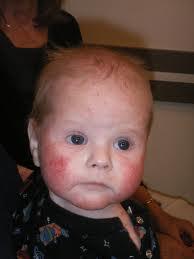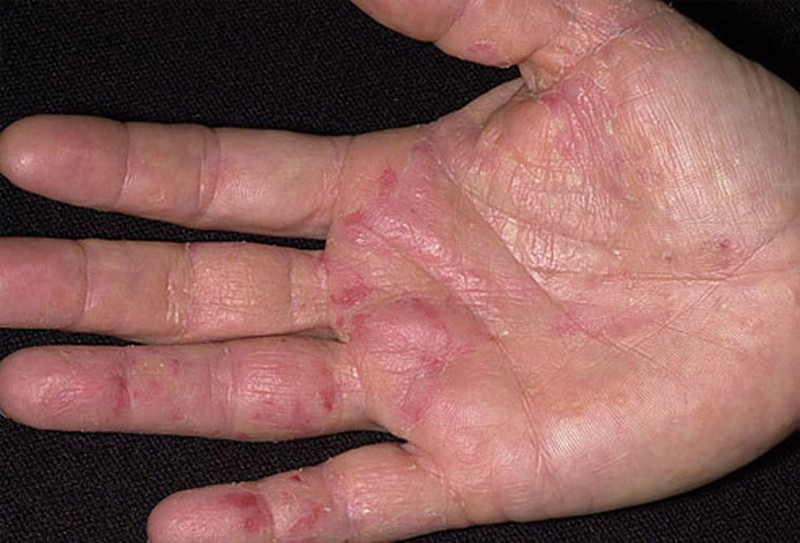
At High-risk
Eczema occurs in both children and adults, but usually appears during infancy. Although there is no known cause for the disease, it often affects people with a family history of allergies.
Those who are genetically predisposed and then exposed to environmental triggers may develop eczema. Many people who have eczema also suffer from allergic rhinitis and asthma, or have family members who do.
Causes
Many substances have been identified as itch "triggers" in patients with eczema, and triggers are not the same for every person. Many times it is difficult to identify the exact trigger that causes a flare-up. For some, it seems that rough or coarse materials coming into contact with the skin causes itchiness. For others, feeling too hot and/or sweating will cause an outbreak. Other people find that certain soaps, detergents, disinfectants, contact with juices from fresh fruits and meats, dust mites, and animal saliva and danders may trigger itching. Upper respiratory infections (caused by viruses) may also be triggers. Stress can also sometimes aggravate an existing flare-up. Synthetic clothes and woolens worn directly on the skin can also start an itch in a patient of eczema.
Treatment
One of the most important components of an eczema treatment routine is to prevent scratching. Because eczema is usually dry and itchy, the most common treatment is the application of lotions or creams to keep the skin as moist as possible. These treatments are generally most effective when applied directly after bathing (within three minutes is a common recommendation) so that the moisture from the bath is "locked in." Cold compresses applied directly to itchy skin can also help relieve itching. If the condition persists, worsens, or does not improve satisfactorily, another effective treatment is the application of nonprescription corticosteroid creams and ointments to reduce inflammation.
Alternatives to nonprescription corticosteroids include more potent prescription corticosteroid creams and ointments, which are effective, but which may have some side effects.
To prevent side effects such as skin thinning, your doctor may limit the length of treatment time and locations where you can apply treatment. For severe flare-ups, your doctor may prescribe oral corticosteroids,but this treatment is not recommended for long-term use.
Skin affected by eczema may frequently become infected. If this happens to you, your doctor may prescribe topical or oral antibiotics . For severe itching, sedative antihistamines are sometimes used to reduce the itch and are available in both prescription and over-the-counter varieties. Because drowsiness is a common side effect, antihistamines are often used in the evening to help a person restless from eczema get to sleep.. Finally, in cases where eczema is resistant to therapy, your physician may prescribe the drug cyclosporine A, which modifies immune response; however, this is used only in extreme cases because of its association with serious side effects.
Two topical medications, tacrolimus and pimecrolimus, have now been approved to treat atopic dermatitis. Pimecrolimus and tacrolimus are a much-welcomed addition because they have not produced some of the side effects associated with long-term topical corticosteroid use, such as thinning skin and loss of effectiveness.
Differentiation between Eczema and Atopic Dermatitis
Eczema is a general term encompassing various inflamed skin conditions. Atopic dermatitis is one of the common forms of eczema. Approximately 10 percent to 20 percent of the world population is affected by this chronic, relapsing, and very itchy rash at some point during childhood. Fortunately, many children with eczema find that the disease clears and often disappears with age.
In general, atopic dermatitis will come and go, often based on external factors. Although its cause is unknown, the condition appears to be an abnormal response of the body's immune system. In people with eczema, the inflammatory response to irritating substances overacts, causing itching and scratching. Eczema is not contagious and, like many diseases, currently cannot be cured. However, for most patients the condition may be managed well with treatment and avoidance of triggers.
Prevention
Eczema outbreaks can usually be avoided with some simple precautions. The following suggestions may help to reduce the severity and frequency of flare-ups:
- Moisturize frequently,and also immediately after bath
- Avoid sudden changes in temperature or humidity
- Avoid sweating or overheating
- Reduce stress
- Avoid scratchy materials (e.g., wool or other irritants)
- Avoid harsh soaps, detergents, and solvents
- Avoid environmental factors that trigger allergies (e.g., pollens, molds, mites, and animal dander)
- Be aware of any foods that may cause an outbreak and avoid those foods
- Avoid long and hot showers

What can be done for children with eczema?
Children are unique patients because it may be difficult for them to resist scratching their eczema, thereby making the condition worse. Fortunately, for mild to moderate cases, the application of moisturizer on a regular basis can be very helpful. And, in most cases, the eczema will disappear as the child ages. In the meantime, avoid as many eczema triggers as possible. Keep your child's skin moist. After bathing, apply moisturizer within three minutes to retain the moisture in the skin. Avoid sudden temperature changes. Keep your child's bedroom and play areas free of dust mites (a common trigger). Use mild soaps – both on your child's skin and on your child's clothing. Dress your child in breathable, preferably cotton, clothing.
If these methods fail to help your child, you should seek further advice from a dermatologist. After consultation, an over-the-counter cream, a prescription cream, ointment, antihistamines, or antibiotics may be advised. Regardless, most children will see improvement as time goes by.
Lifestyle modifications are the first line of defense in controlling eczema, regardless of whether the eczema is mild, moderate, or severe.
Recommended by dermatologists, the following guidelines can help reduce the severity and frequency of flare-ups, which also may decrease the need for anti-inflammatory medicine. Continuing to follow these guidelines once the signs and symptoms clear can help prevent further outbreaks:
1. Moisturize, moisturize, moisturize.
Eczema is usually dry and itchy, so applying moisturizers as needed to keep the skin moist is part of an effective treatment plan. Frequent moisturizing locks in the skin’s own moisture to prevent dryness and cracking. One of the best ways to lock in moisture is to apply moisturizer after bathing. When bathing, care must be taken to avoid irritating the skin.
2. Limit contact with anything that irritates the skin.
Soaps, bubble bath, perfumes, cosmetics, laundry detergents, household cleaners, too much time spent in water, finger paints, gasoline, turpentine, wool, a pet’s fur, juices from meats and fruits, plants, jewelry, and even lotions can irritate sensitive skin. Know what irritates your skin and limit contact with all that does. Avoiding personal-care products that contain alcohol and not washing hands too frequently also will help reduce irritation.
3. Avoid sweating and overheating.
triggers of the scratch/itch cycle are sweating and overheating. It is essential to prevent these situations whenever possible.
4. Avoid sudden changes in temperature and humidity.
A sudden rise in temperature can cause overheating and sweating. A drop in humidity can dry skin and lead to a flare-up.
5. Grab a cold compress to curb the itch.
Scratching makes the condition worse and may puncture skin allowing bacteria to enter and cause an infection. Gently applying a cold compress to the area that itches can reduce inflammation and lessen the desire to scratch.
6. Keep fingernails short.
Short nails decrease the likelihood that scratching will puncture the skin. Keeping nails short and wearing cotton gloves at night may help prevent scratching that punctures the skin while asleep.
7. Dress in loose-fitting cotton clothes.
Synthetic fabrics, wool, and other materials that feel rough to the touch often irritate the skin and trigger a flare-up. Cotton and cotton-blend clothes usually make skin feel better.
8. Double rinse clothes, and wash new clothes before wearing.
Laundry detergents can trigger flare-ups. Using a fragrance-free, neutral pH detergent and double rinsing clothes can help prevent flare-ups caused by laundry detergent. It also may be helpful to wash new clothes before they are worn as washing removes excess dyes and fabric finishers, which can irritate the skin. Tags should be removed, too, as these can rub the skin, causing irritation.
9. Reduce stress.
Stress reduction plays a key role in preventing eczema flares. In today’s fast-paced world, reducing stress can be challenging; however, there are ways to effectively reduce stress.
10. Follow a prescribed treatment regimen.
Moisturizing and using medications as directed by a dermatologist go a long way toward keeping flare-ups at bay. For Atopic Dermatitis Only Since atopic dermatitis is a type of eczema that occurs in people who have an inherited predisposition to allergies, such as asthma, hay fever, or food allergies, the following also can help prevent a flare-up:
11. Limit exposure to environmental triggers.
Pollens, molds, mites, and animal dander can cause flare-ups. When pollen and mold counts are high, limit time outdoors.
12. Find out if any food(s) triggers the atopic dermatitis.
If you suspect a food allergy is a trigger, be sure to tell your dermatologist. Tests can be run to determine which, if any, food allergies exist.


